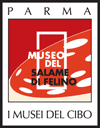Organised in 5 distinct sections, the museum visit begins with historical evidence of the relationship between Parma and its key product, not forgetting the famous black Parma pig.
The second section dedicated to gastronomy is set, not by chance, in the fascinating kitchen area of the Castle and presents the various ways in which salami can be used in the cuisine of Parma with a particular section dedicated to the integration between production and consumption on a Jesuit owned farm.
The visit continues to the large room where the section given over to pig-butchery and homemade salami production, with a video showing a photographic sequence telling the whole story of the rite of killing the pig and what happens afterwards.
Continuing and completing this section, there is a large display of objects which belonged to the ‘norcino’ or itinerant pig butcher, and to the families of agricultural workers; notice, in particular, the special cloak worn by pig butchers.
The following room presents the various technologies of production, representing the significant characteristics from the origins to the pre-industrial period, up to present day technology with the “identity card” of today’s product. In the centre of the room can be seen a large machine used for stuffing pig-gut with the salami mixture.
A section dedicated to marketing and commercialisation of the product presents documents relative to the sale of Felino salami beginning in the XVIII century.
The final room is set aside for watching a video prepared for the Museum which re-evokes moments using some of the traditional production methods of yesteryear followed by a sequence on modern techniques.
Finally, there is a small section devoted to curiosities, amongst which the story of Du Tillot, Marquis of Felino and Prime Minister to the Duke of Parma.


